Laptop Mag Verdict
The MSI GS66 Stealth combines power and endurance into a sleek, attractive package
Pros
- +
Sleek, attractive design
- +
Good overall and gaming performance
- +
Excellent battery life
- +
Blistering-fast transfer speeds
Cons
- -
Display could be brighter and more vivid
- -
Keyboard a bit mushy
Why you can trust Laptop Mag
MSI’s Stealth line sits at the top of our list of thin-and-light gaming laptops, and with good reason. They’re extremely portable, tend to pack beastly hardware, and have some serious endurance. Such is the case with the new MSI GS66 Stealth. The notebook brings the stunning good looks we’ve come to expect from the line and beefs up the power with Nvidia’s new 30-series GPUs and a 1440p display with a super-high refresh rate. And for multitasking, you get a strong Intel Core i7 processor. Plus, the notebook has the biggest battery the TSA allows, which ups the endurance factor.
It’s so close to being perfect. But the display could be brighter and more vivid, and the keyboard could offer a little more bounce. But pound, for barely-there pound, the MSI GS66 earns its place on our Best Gaming laptops page and best VR-ready laptops page.
MSI GS66 Stealth pricing and configurations
Price: $2,499
CPU: Intel Core i7-10850H
GPU: Nvidia GeForce RTX 3080/Intel UHD Graphics
RAM: 16GB
Storage: 1TB NVMe SSD
Display: 1080p, 240Hz
Battery: 6:27
Size: 14.2 x 9.7 x 0.7 inches
Weight: 4.5 pounds
The MSI GS66 Stealth starts at $1,799 and has a 2.6-GHz Intel Core i7-10750H processor with a 16GB of RAM, a 1TB NVMe SSD, an Intel UHD Graphics GPU, an Nvidia GeForce RTX 3060 GPU with 6GB of VRAM, and a 15.6-inch 1920 x 1080-pixel display with a 240Hz refresh rate and 3ms response rate.
The mid-tier model costs $2,399 and comes with a 2.2-GHz Intel Core i7-10850H CPU, 32GB of RAM, a 1TB NVMe SSD, an Intel UHD Graphics GPU, an Nvidia GeForce RTX 3070 Max-Q GPU with 8GB of VRAM, and a 15.6-inch 1920 x 1080-pixel display with a 300Hz refresh rate and 3ms response rate.
The top model is priced at $2,999 and bumps the configuration up to a 2TB NVMe SSD, an Intel UHD Graphics GPU, an Nvidia GeForce RTX 3080 Max-Q GPU with 16GB of VRAM, and a 15.6-inch, 1920 x 1080 display with a 300Hz refresh rate and 3ms response rate.
I’m reviewing a yet to-be-released model will be released in Q2 and pricing is TBD. It has a 2.2-GHz Intel Core i7-10850H CPU, 16GB of RAM, a 1TB NVMe SSD, an Intel UHD Graphics GPU, an Nvidia GeForce RTX 3080 with 16GB of VRAM, and a 15.6-inch, 1920 x 1080-pixel display with a 240Hz refresh rate and 3ms response rate.
MSI GS66 Stealth design
All black everything. The Stealth dazzles in ebony sandblasted aluminum and looks like it’d be a prominent tool in 007’s extensive arsenal. The lid has just enough shimmer to pull you in while the black dragon emblem glimmers gently in the light. The rear vents are subdued, a nice change from the supercar inspired design you see on other gaming rigs.
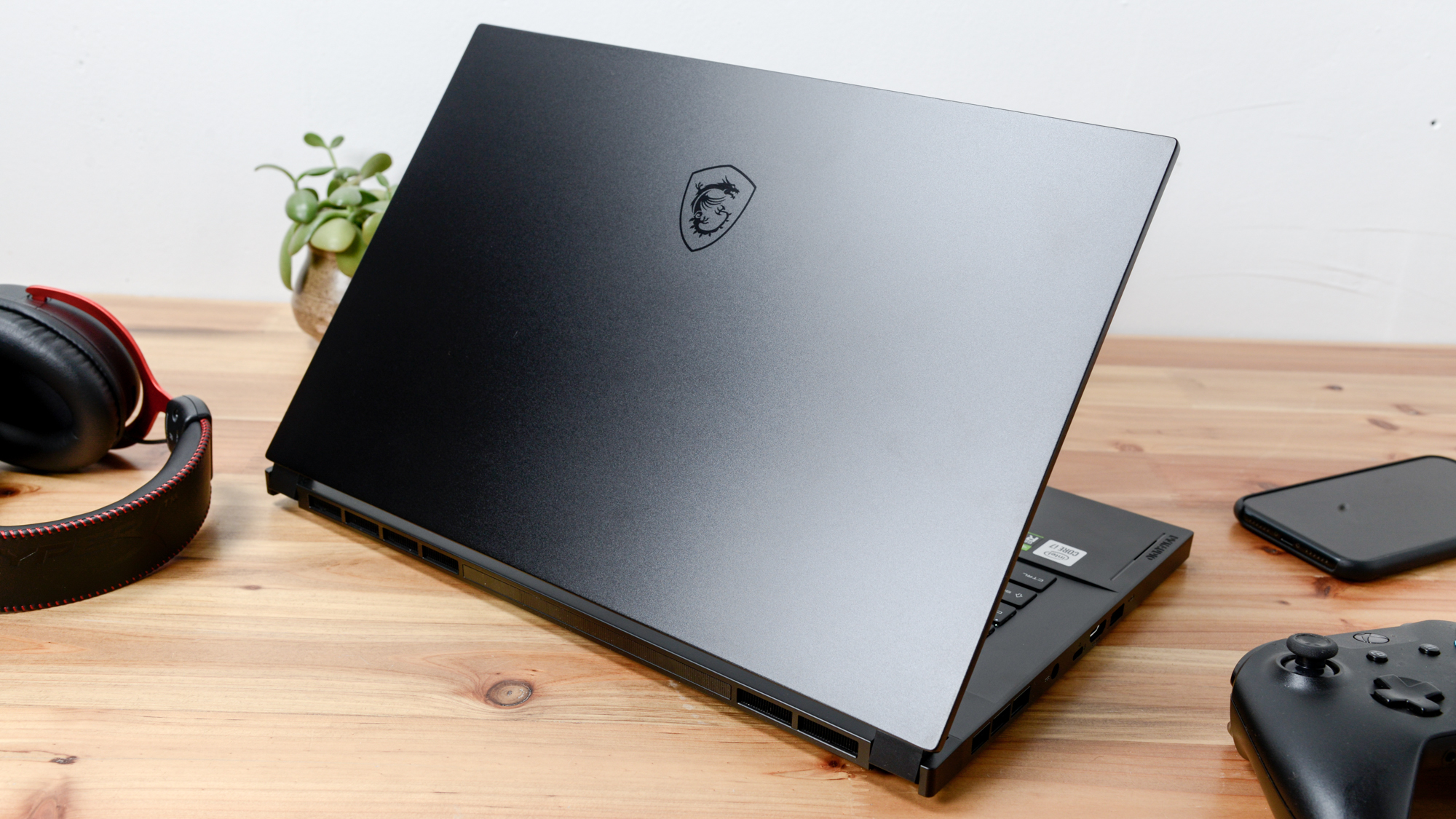
When you open the notebook, you get more of that sandblasted black aluminum deck. The keyboard sits in the middle of the deck in a slight recess. Directly below is the palm rest with a rather large touchpad. The top of the deck is occupied by a large vent grille.
Weighing only 4.5 pounds, the 14.2 x 9.7 x 0.7-inch Stealth is the lightest laptop of its cohorts. But the Aorus 15G (14 x 9.6 x 0.9 inches) and Razer Blade 15 Advanced Edition (14 x 9.3 x 0.7 inches) aren’t too far behind, at 4.7 pounds. The Alienware m15 R4 (14.2 x 10.9 x 0.7~0.8 inches) tips the scale at 5 pounds.
MSI GS66 Stealth security
The MSI GS66 Stealth doesn’t have many security features, but it does have an IR camera for Windows Hello facial recognition login.
MSI GS66 Stealth ports
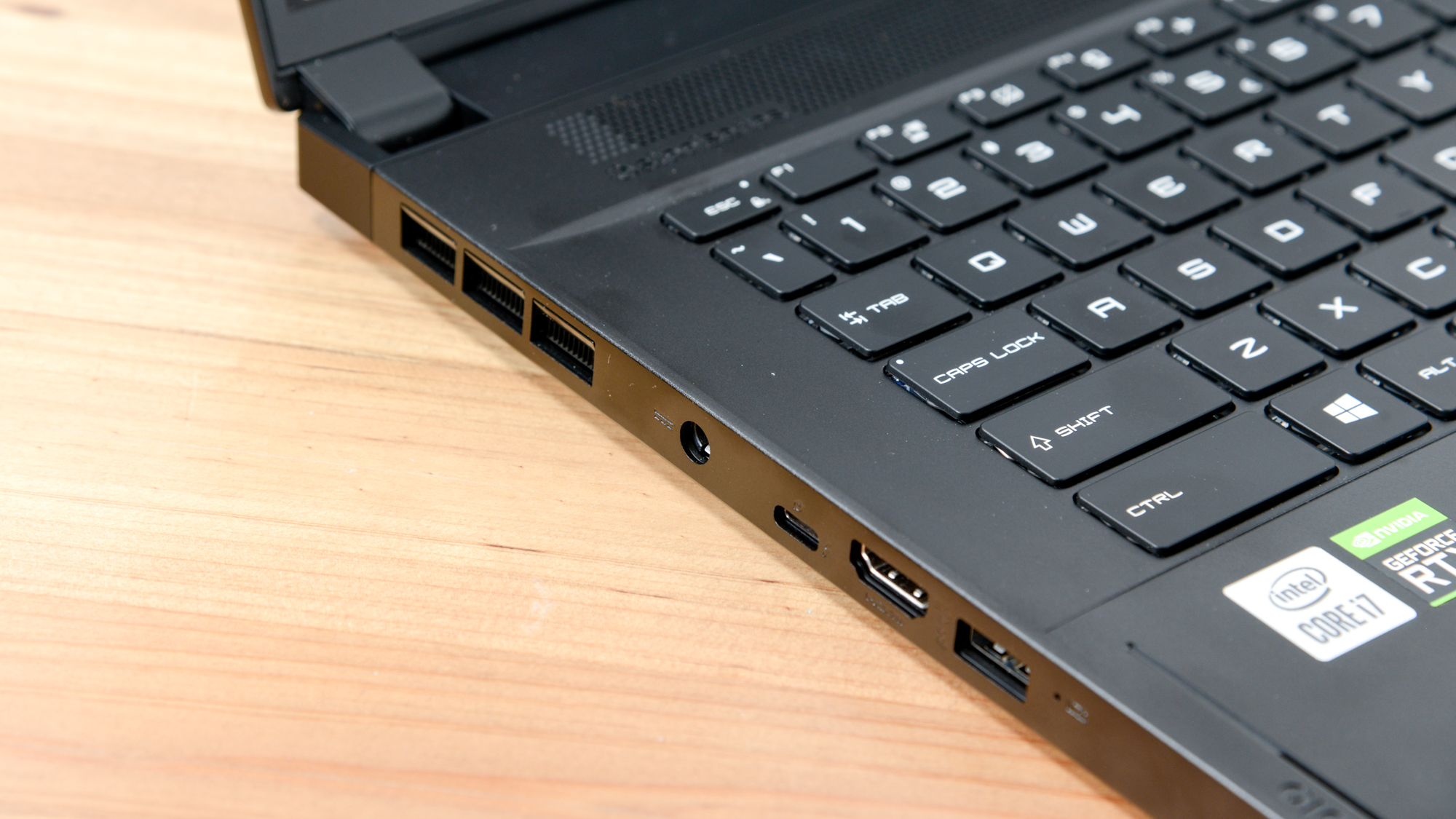
For such a slim system, the MSI GS66 Stealth has a healthy amount of ports. On the right side are a pair of USB 3.2 Gen 2 Type-A ports, a USB 3.2 Gen Type-C port, an input for Gigabit Ethernet and a headset jack. Another USB 3.2 Gen 2 Type-A port resides along the left with a Thunderbolt 3 port, an HDMI 2.0 port and the power port.
MSI GS66 Stealth display
The MSI GS66 Stealth is one of the latest gaming laptops to feature a display with a 2560 x 1440p resolution and a 240Hz refresh rate. We expect to see this configuration a lot as time goes on as this appears to be the sweet spot gamers are looking for –– super high resolution combined with an equally high refresh rate (number of times a screen shows a new image every second). Throw in a 3-millisecond response rate (the time it takes the panel to switch from one color to another) and you’re in for beautiful vistas and silky smooth image rendering, the latter of which can lead to more accurate shots when playing shooters.
I booted up CyberPunk: 2077. As I made my Nomad V, I admired her dark skin tone that contrasted beautifully with her magenta locs. And when I got my first cybernetic upgrade, I could see the intricate fibers of my new mechanical hand along with the metal servos.
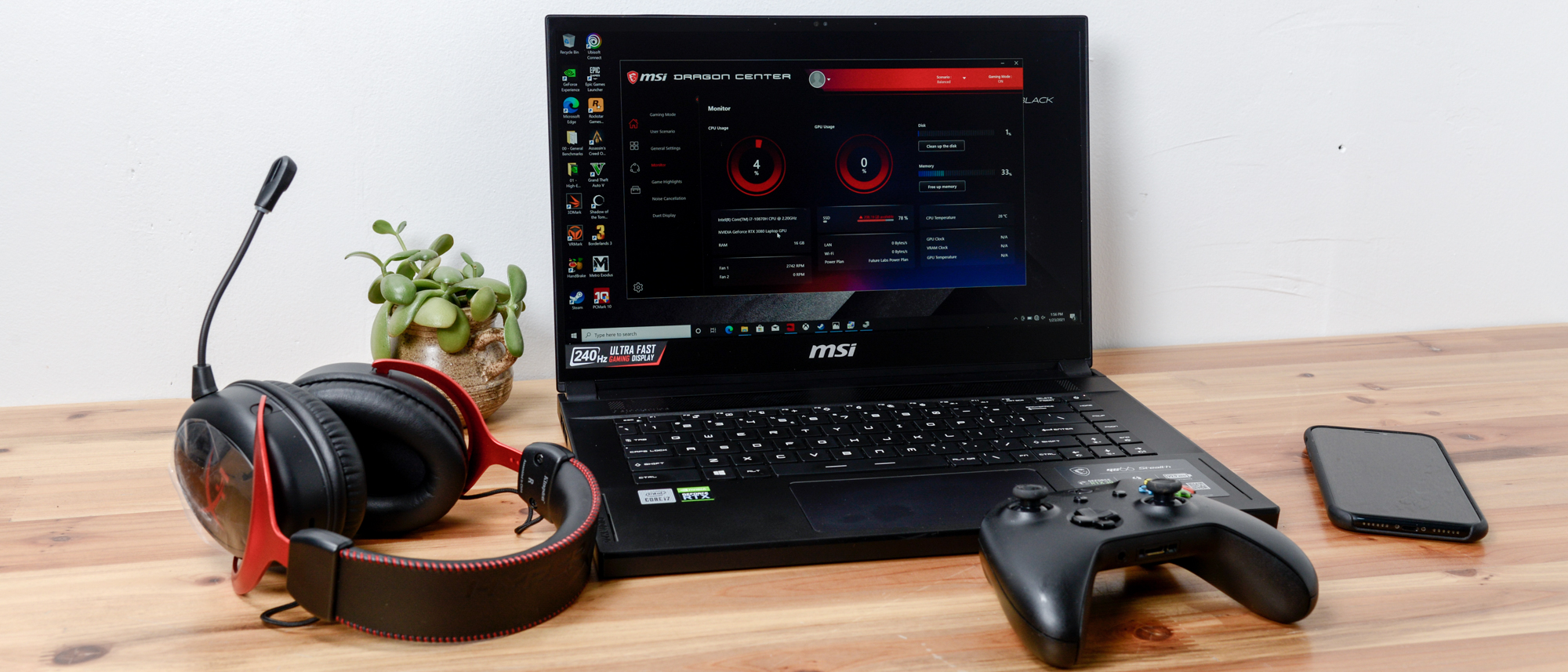
Watching the trailer for If Not Now, When?, the vivid blush pink looked a little darker than I’m used to, but it still captured my attention. That darkened pall also extended to the actresses in the scene, making their complexions look ruddier than usual. Details were sharp enough for me to see the flyaway strands of hair protruding from one of the actresses’ curly pompadour, particularly a lone strand laying nonchalantly on her forehead.
Measuring for color reproduction, we discovered the Stealth only reached 69.9% of the DCI-P3 color gamut. That result is well short of the 90.9% premium gaming laptop average. The Aorus 15G and Blade 15 had a better showing at 76.7% and 80%, respectively. The m15 R4 was the most vivid at 149.5%.
I was hoping for a bit of a comeback on the brightness test, but no such luck. The Stealth averaged 272 nits, which is better than the Aorus 15G’s 259 nits. But it wasn’t a match for the Blade 15’s 280 nits nor the m15 (362 nits) or category average (344 nits).
MSI GS66 Stealth audio
Those two tiny slits on either side of the MSI GS66 Stealth’s palm rest pack quite a wallop. Boosted by Nahimic’s software, the Dynaudio 2-sided Duo speakers had no problems blanketing my living and dining rooms in clean, loud audio. The strings during the intro on Estelle’s “Stronger Than You” were sturdy and gave way to a jazzy, synthy keyboard and crisp percussion. The singer’s rich vocal, which blurred the line between alto and tenor, reigned supreme.
As I made my way to my next mission in CyberPunk, I put the pedal to the metal and enjoyed hearing my car’s turbo boost roar as I hit a straightaway. A synthy, bass-heavy bop played in the background. It was an invigorating moment that soon gave way to the staccato rhythm of an assault rifle as I reached my mission objective and went in guns blazing.
MSI GS66 Stealth keyboard and touchpad
Typing on the MSI GS66 Stealth’s Chiclet keyboard is a pleasurable experience once you get used to it. The keys, while large with nice spacing, are a bit mushy for my taste. However, they have just enough feedback to make it comfortable. I hit 72 words per minute on the 10fastfingers typing test, which is slightly above my normal 70 wpm.
As with most gaming laptops, you can customize the anti-ghosting keyboard key-by-individual-key with the SteelSeries 3 engine. You create a custom color scheme using the 16.8 million colors in the lineup, complete with a bevy of effects, or you can hit the SteelSeries button in the function key row, which lets you cycle between eight dazzling preconfigured profiles.
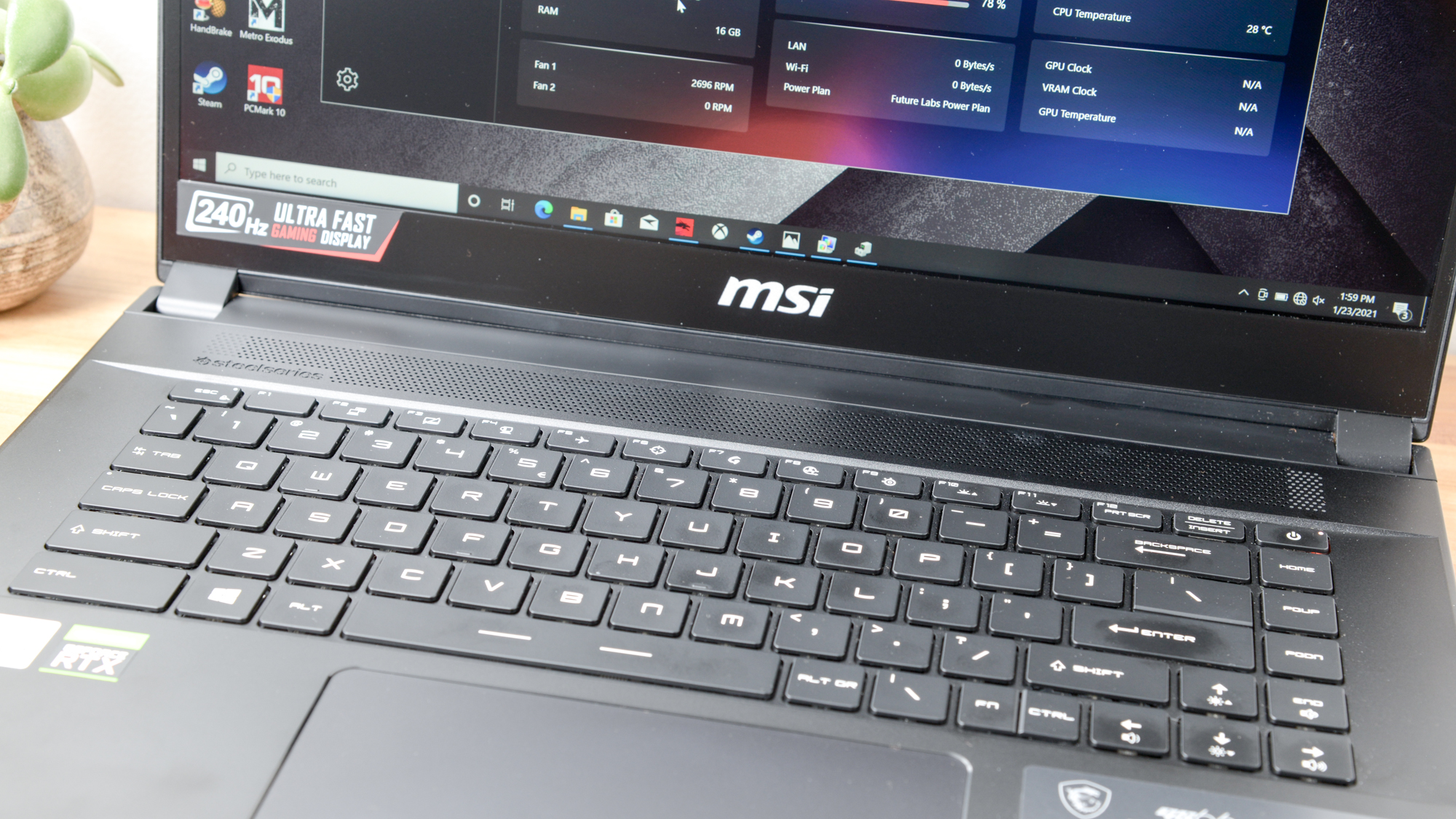
Want more functionality? Try the GameSense feature, which syncs up the lighting for certain games to blink or flash when something important happens. For instance, in Counter-Strike: Global Offensive, you can map certain keys to react to getting kills and scoring a headshot, in addition to keeping tabs on your health and ammo. You also can map several macros to one key. And all your settings are saved to the cloud with the CloudSync feature for use wherever you go.
At 5.5 x 2.6 inches, the Stealth’s glass touchpad is ludicrously long, stretching across a substantial amount of the palm rest. But despite its size, I never accidentally sent the cursor careening across the page when my palm came in contact with the touchpad. And when it was time to whip out those Windows 10 gestures, like pinch-zoom, two-finger scroll and three-finger flick, the touchpad delivered a rapid, accurate response.
The bottom corners of the touchpad depress with an audible click when using them as mouse buttons.
Meet Nvidia 30-series GPUs
The MSI GS66 Stealth is one of the first gaming laptops to grace my lap with an Nvidia GeForce RTX 3080 GPU. The chip and its 16GB of video memory are bringing faster performance and twice the efficiency. The new 30-series chip uses Nvidia’s 2nd-generation RTX Ampere architecture, which is the company’s first 8nm chip. Despite the smaller size, Nvidia still managed to fit even more transistors on the chipset. How many more? Billions. More transistors means more power, which is rarely a bad thing.
Made using a custom system, for all intents and purposes, Ampere chips are three processors in one. You’ve got the Shader, which handles 3D shading (lighting, darkness, color levels) in a rendered image as well as other post-processing functionality. There are 2nd-generation RT Cores that handle that all-important ray-tracing technology and a 3rd-generation Tensor Core, which powers artificial intelligence calculations.
But what’s the use of all that power without some kick-ass functionality? With the Ampere chips, 30-series laptops will bring a host of gamer-centric features including the 3rd-generation of Max-Q design, which brings with it Dynamic Boost 2.0 and WhisperMode 2.0. Powered by AI, Dynamic Boost 2.0 intelligently sends power between the processor, GPU and VRAM as necessary for that efficiency that I mentioned earlier. The improved WhisperMode also works with the CPU and GPU as well as the laptop’s fans. By monitoring system temperature, WhisperMode provides the optimal acoustics so you don’t have to worry about blaring fan noise.
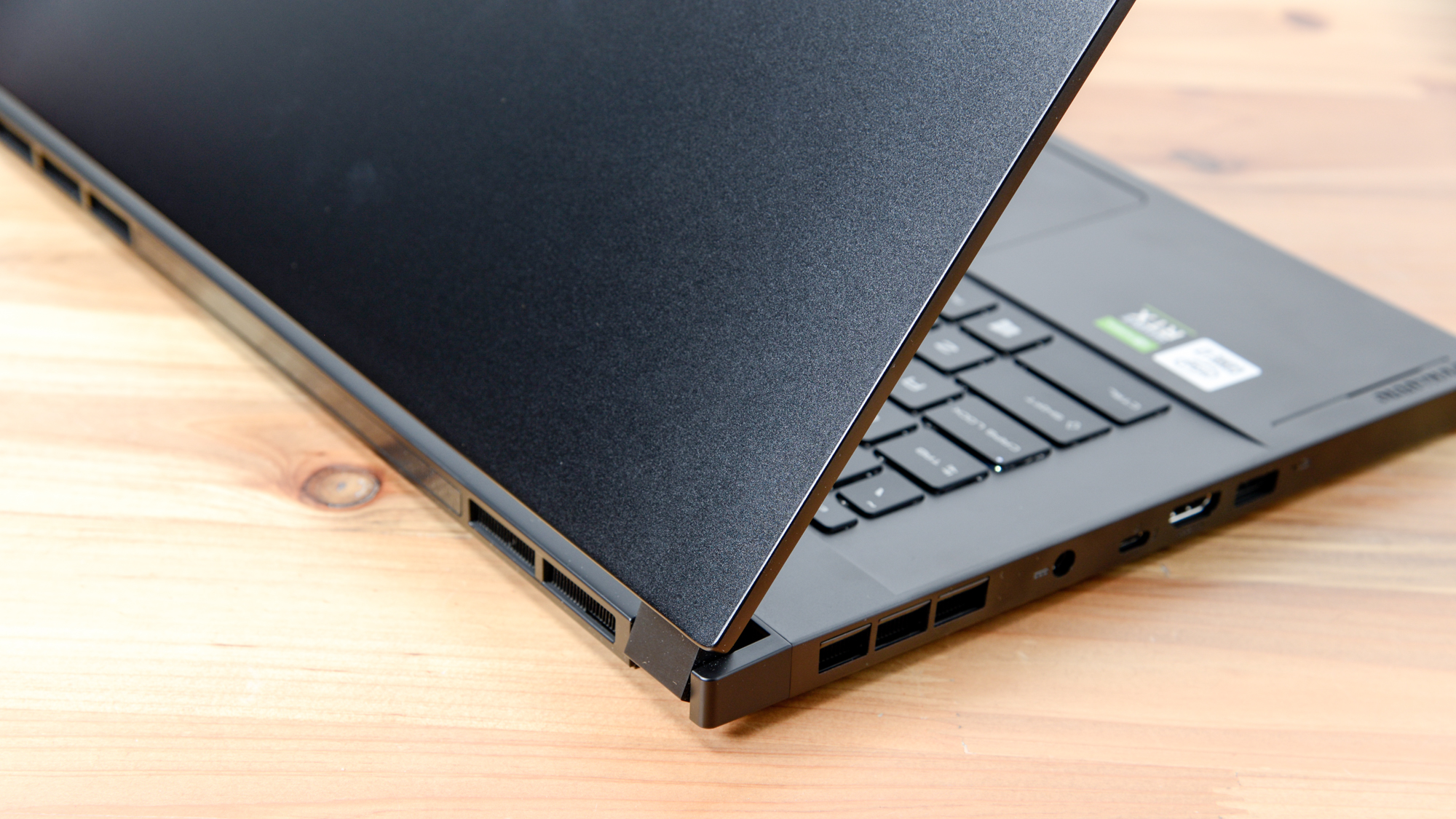
Another AI-powered feature is DLSS or Deep Learning Super Sampling. DLSS allows a gaming laptop, which has more pronounced power restraints, to achieve 2x the performance without exceeding thermal or power limits. It helps deliver those high frame rates you’ve come to expect from a high-end Nvidia system.
Nvidia’s Optimus technology has also gotten an upgrade. For the uninitiated, Optimus automatically switches between integrated and discrete graphics to preserve battery life. Less taxing programs use integrated GPUs while games, photo and video-editing software will tap into discrete GPUs. This latest iteration of the feature, called Advanced Optimus, uses a hardware switch that controls which GPU is connected to the display at any given time.
Unlike previous versions, Advanced Optimus plays nice with Nvidia’s G-Sync technology. G-Sync matches up the display’s refresh rate with the GPU for a smoother, faster gaming experience. With Advanced Optimus, gamers get the benefit of longer battery life and displays that push out higher refresh rates (1440p displays at 240Hz and 4K at 120Hz). The feature can be toggled between Automatic, Optimus and Nvidia GPU-only in the Nvidia Control Panel.
Speaking of displays, you’re going to see a lot more gaming laptops with 1440p display options and super high refresh rates. This is by design. Although we are seeing a lot more 4K panels, some with refresh rates higher than 60Hz, 1440p panels with 240Hz hit that sweet spot of high-res graphics and a super high refresh rate.
Another performance enhancement comes by way of the Resizable Bar. Instead of the video memory having to process smaller processing requests at a time, Resizable Bar allows the CPU to access the framebuffer capability in one big batch, which is better for performance.
Other Nvidia goodies are Reflex, which uses G-Sync tech to cut down on latency, the bane of any gamer’s existence. Broadcast allows you to turn a meager gaming nook into a passable streaming headquarters by way of AI functionality, which cancels out ambient noise, automatic webcam framing and the ability to create virtual background effects.
MSI GS66 Stealth graphics, gaming and VR
This is a big level up. The MSI GS66 Stealth is the latest entrant to the Nvidia RTX 3080 club and for a laptop so undeniably svelte, it’s putting up some monstrous numbers against the competition. And when you aren’t gaming, the system uses Nvidia’s Optimus technology to automatically switch to its integrated Intel UHD Graphics.
Our benchmarks started with Shadow of the Tomb Raider where the Stealth hit 87 fps (Highest, 1080p, DX 12), beating the 72-fps premium gaming laptop average. With their RTX 3070 GPUs, the m15 R4 and Aorus 15G reached 77 and 78 fps, respectively. Changing the resolution to 1440 saw the Stealth frame rate drop to 61 fps, which is still pretty good.
On the Assassin’s Creed Odyssey test, the Stealth reached 66 fps at 1080p, beating the 61-fps category average as well as the Aorus 15GB (62 fps) and the Blade 15 (54 fps, RTX 2080 GPU). However, the m15 R4 narrowly pulled out the win with 67 fps. At 1440p, the Stealth produced 57 fps.
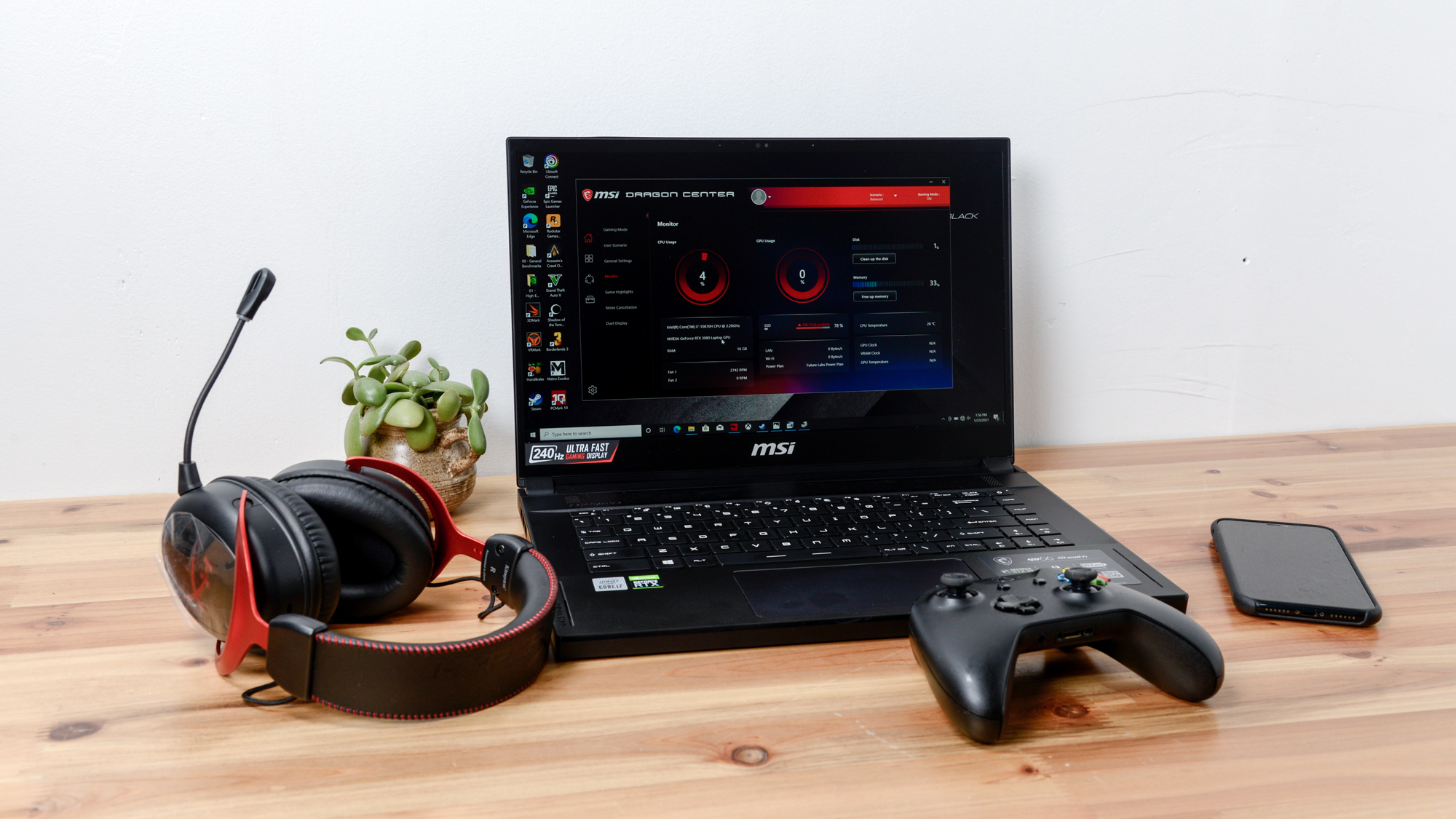
When we ran Assassin’s Creed Valhalla, the Stealth notched 68 fps at 1080p while the Alienware and Aorus hit 70 fps and 63 fps, respectively. Switching to 1440, the MSI delivered 55 fps.
During the Metro: Exodus RTX benchmark, the Stealth got 63 fps on 1080p and 55 fps on 1440. The Aorus 15G pulled 54 fps, matching the average, while the Blade 15 scored 48 fps. But the m15 R4 was the penultimate winner at 66 fps.
The Stealth dispatched 93 fps at 1080p and 86 fps at 1440p on the Far Cry New Dawn test. Both scores are better than the 85-fps average, the Blade 15 (86 fps) and m15 R4 (91 fps). The Aorus 15G managed to tie at 93 fps.
We saw the Stealth obtain frame rates of 84 fps (1080p) and 59 fps (1440p) during the Borderlands 3 benchmark. The 1080p score was enough to cruise past the 66-fps average as well as the 62 fps and 70 fps put up by the Blade 15 and the Aorus 15G, respectively. The m15 R4 tied the Stealth with 84 fps.
Running the Red Dead Redemption 2 saw the Stealth score 71 fps at 1080p and 52 fps at 1440p. The laptop defeated the 55-fps average along with the Blade 15 (54 fps), Aorus 15G (59 fps) and m15 R4 (69 fps).
To test VR readiness, we ran VRMark Orange room and the Stealth reached 8,426, surpassing the 8,184 average and the Blade 15’s 7,784. However, the Alienware and Aorus had better results at 8,540 and 8,485, respectively.
MSI GS66 Stealth performance
MSI suited the GS66 Stealth up with a 2.2-GHz Intel Core i7-10870H CPU, 16GB of RAM and a 1TB NVMe SSD. This notebook is no pushover when it comes to multitasking. I watched an episode of Lupin on Netflix with 40 additional tabs open –– some running Twitch and YouTube, others running Tweetdeck and some inordinately long GDoc spreadsheets. The Stealth took it like a champ and didn’t exhibit any slowdown.
The Stealth held its own against the competition, obtaining 6,078 on the Geekbench 5.3 overall performance test. It beat the Blade 15 (5,964, Core i7-10875H CPU), but fell short of the 7,427 premium gaming laptop average as well as the Alienware (7,636) and Aorus 15G (8,009), which also have Core i7-10870H processors.
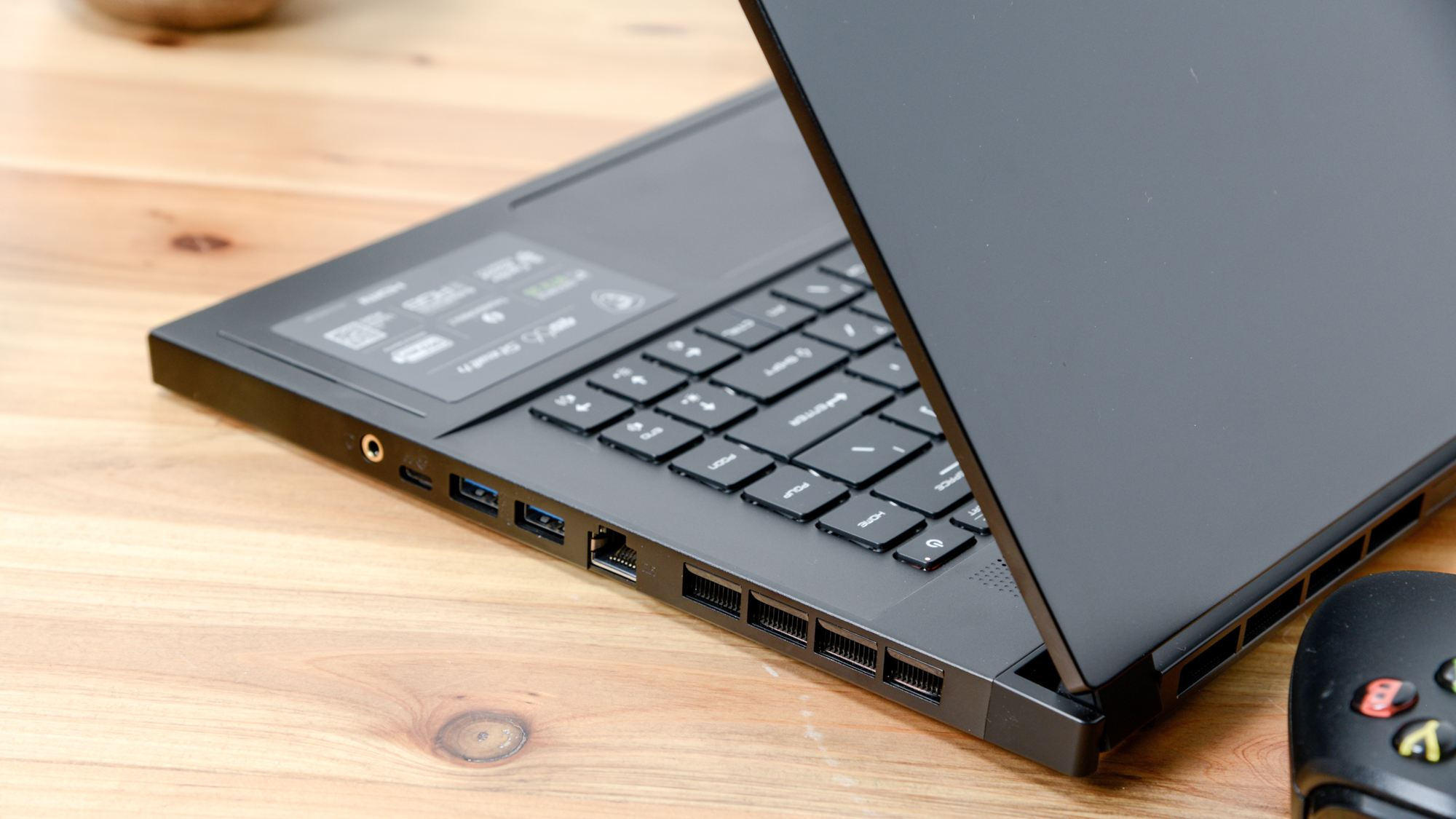
It took the Stealth 9 minutes and 1 second to transcode a 4K video to 1080p on the Handbrake test, which was a faster time than the Blade 15’s 10:32. Unfortunately, it was slower than the 8:24 average and the 8:05 and 7:07 posted by the Aorus 15G and m15 R4, respectively.
During the file transfer test, the Stealth produced a transfer rate of 1,050.6 megabytes per second duplicating a cache of 25GB of mixed-media files. That was enough to top the 887.7 MBps category average, the Blade 15’s (1TB M.2 NVMe SSD) 852.6 MBps and the Aorus 15G’s (512GB SSD) 928 MBps. But it wasn’t a match for the m15 R4 (1TB SSD) which obtained 1,147 MBps.
MSI GS66 Stealth battery life
When I first began reviewing gaming laptops, I was lucky if a system lasted an hour on the Laptop Mag Battery test (continuous web surfing over Wi-Fi at 150 nits of brightness). Nowadays, it’s not unusual to see a system hit the 5 or 6-hour mark.
Such is the case for the MSI GS66 Stealth, which posted a time of 6 hours and 27 minutes, crushing the 4:48 premium gaming laptop average. It helps that the laptop has a 99.9WHr battery, the largest that the TSA will allow on an airplane. The Aorus 15G also lasted 4:48 while the m15 R4 and Blade 15 clocked in at 4:01 and 3:12, respectively.
MSI GS66 Stealth heat
Little space, lots of heat. Every gaming laptop OEM is constantly fighting the battle against heat which subjects your powerful laptop to throttling thanks to overheated components. MSI’s solution is its CoolerBoost technology. It consists of seven heat pipes and three fans with 0.004-inch thin fan blades, making them the world’s thinnest sharp-edged fan design.
When we put the technology to the test, there were still some spots that exceeded our 95-degree Fahrenheit comfort threshold, but it was cooler than what we’ve seen on other systems. The touchpad, center and bottom of the Stealth measured 81, 108 and 111 degrees, respectively.
Once the system cooled off, we ran our 15-minute video streaming test and remeasured it. The touchpad hit 82 degrees while the middle of the keyboard measured 87 degrees. The laptop’s undercarriage registered 91 degrees.
MSI GS66 Stealth software and warranty
MSI bundled all of its gamer-centric utilities into Dragon Center for one-stop access. It’s here that you’ll find SteelSeries Engine 3, but you can also monitor system diagnostics, perform light maintenance, and switch between fan and power profiles. You can also enable/disable the Windows Key, webcam and the Crosshair display.
The company also added a few more goodies designed for streamers, such as MSI Sound Tune. An AI-powered noise-cancellation technology, Sound Tune works to automatically filter out background noise to prioritize voice, which comes in handy when you’re narrating your latest exploits or just sitting in on a video call. There’s also Duet Display that allows you to game on the main display while capturing important data i.e. maps and inventory on a second connected monitor.

There are also several third-party apps designed to enhance gaming performance, including Killer Control Center, which prioritizes network bandwidth to data-intensive software. The laptop also comes with Nvidia GeForce Experience, which has its own set of helpful functions, including Battery Calibration, Game Optimization, Whisper Mode and In-Game Overlay.
Unfortunately, the notebook has its fair share of bloatware, such as Hulu, Roblox and Hidden City: Hidden Object Adventure. However, some people might find value in apps like MusicMaker Jam, Cyberlink PowerDirector and PhotoDirect.
The MSI GS66 Stealth ships with a 1-year limited warranty. See how MSI fared on Tech Support Showdown and Best and Worst Brands, our annual special reports.
Bottom line
The MSI GS66 Stealth has a lot to offer gamers looking for a true thin-and-light gaming laptop. First, you’ve got the design that looks good anywhere. Next, you’ve got that powerful Nvidia RTX 3080 GPU and the host of new and improved features the company has baked into the chip. And you’ve also got the Core i7 processor for multitasking and an extra-large battery for those extended gaming sessions. Plus, you have a high-res display with a super-high refresh rate.
However, I wish the display was more vivid and brighter, and that the keyboard was a bit firmer. And for yielding an RTX 3080 GPU, there should have been more decisive performance wins. If you’re looking for more power and a better display, the Alienware m15 R4 is worth checking out. But for gamers that crave power, looks and portability, the MSI GS66 Stealth should be at the top of your list.

Sherri L. Smith has been cranking out product reviews for Laptopmag.com since 2011. In that time, she's reviewed more than her share of laptops, tablets, smartphones and everything in between. The resident gamer and audio junkie, Sherri was previously a managing editor for Black Web 2.0 and contributed to BET.Com and Popgadget.
